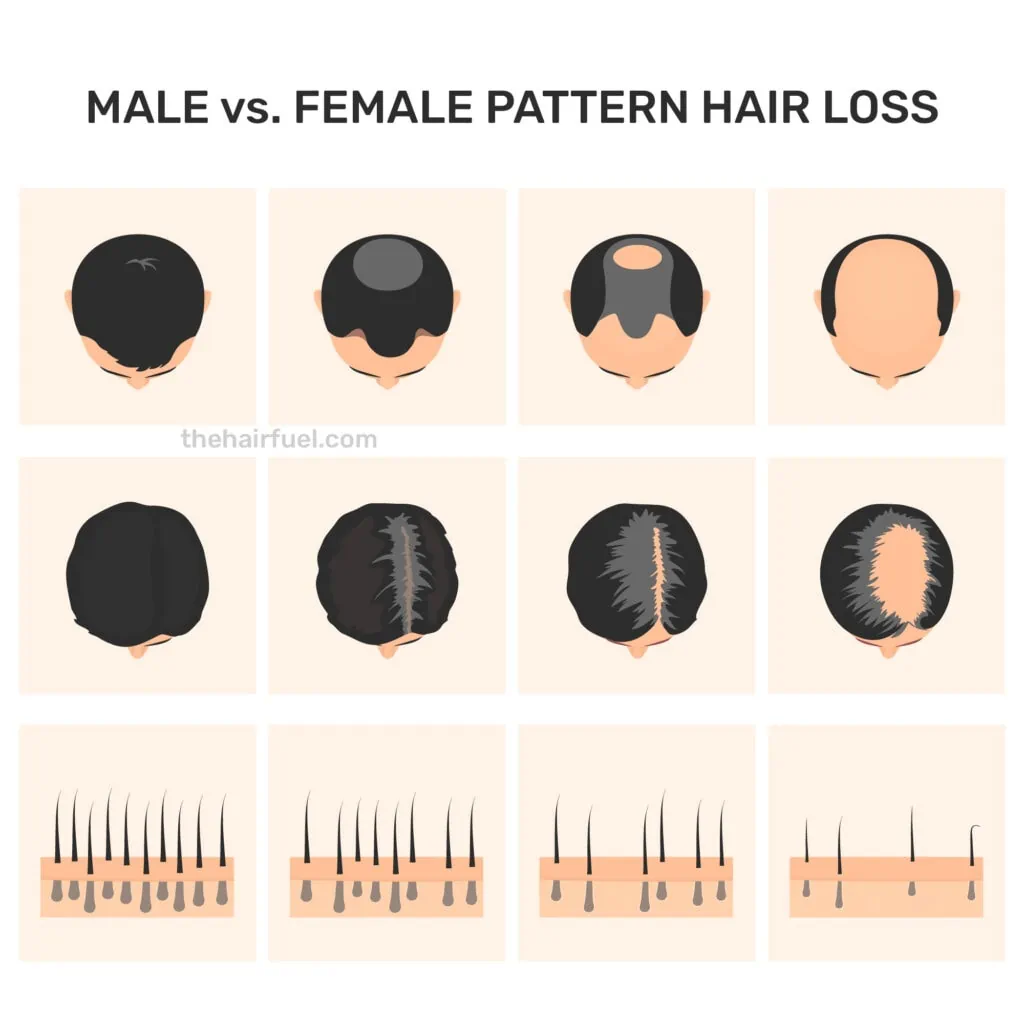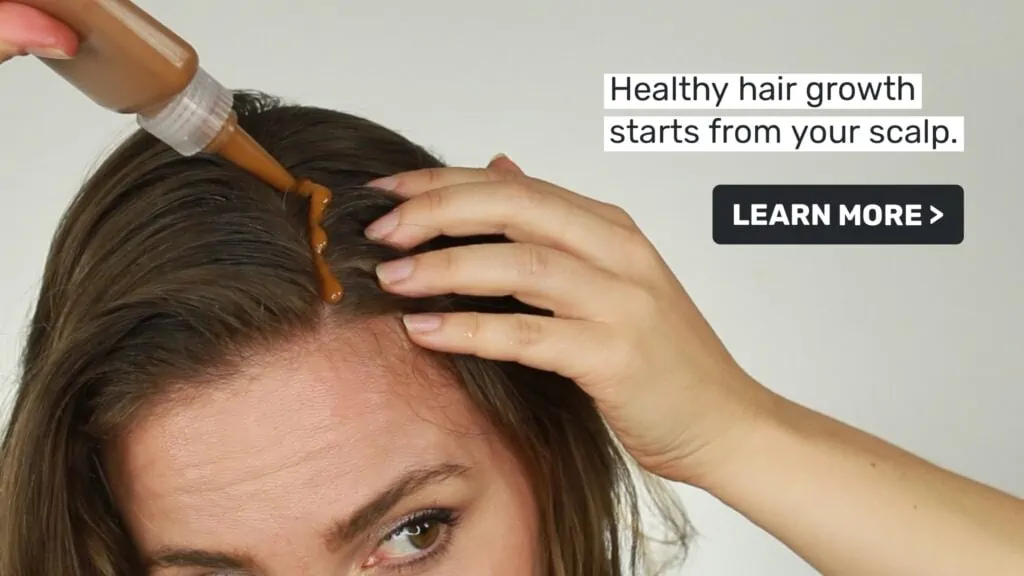Polycystic ovary syndrome (PCOS) is a hormonal disorder, that often causes infrequent, irregular or prolonged menstrual periods. The ovaries develop numerous small collections of fluid (or “follicles”), which often causes failures in regularly releasing eggs. This can lead to challenges with ovulation, conception and pregnancy. Women with PCOS have a hormonal misbalance with elevated levels of androgens (testosterone, DHEAS, and androstenedione) associated with hair loss and hair thinning in a diffuse pattern across your scalp.
Can you grow healthy hair if you PCOS? With this condition, your hair growth becomes something you need manage – below we provide an overview of biology behind PCOS’ impact on your hair as well as techniques, products and tools available.
Hormones in PCOS hair loss
PCOS hair loss is closely related to androgenic alopecia (AGA). “Androgenic” is derived from the noun “androgen,” a word referring to any of the male hormones, despite the name these are present in both, men and women. Elevated levels of androgens can lead to hair thinning and hair loss – on scalp, in a diffuse pattern – also known as female pattern hair loss (FPHL).

AGA is linked to testosterone, an androgen often referred to as “male sex hormone”. While hormones need to be in balance in order for your hair to grow: a blood test can reveal their current state.
The issue with elevated levels of testosterone is that it converts into DHT – dihydrotestosterone – a by-product of testosterone whose aim is to fight local inflammation to the body. As certain parts of our body are inflamed, DHT are rushing to the rescue trying to fix the problem. It’s trying to do a good thing, but ultimately DHT is what leads to thinning hair in women with PCOS.
A number of theories exist, two of the more prominent ones is gravity theory and inflammation theory. Blood flow plays a key role in both of them: since it delivers nutrients to the follicle in order for it to grow healthy hair.
With PCOS diagnosis, you may hear that hair loss is “genetics” and no cure has been found to treat PCOS, but the genes responsible for the enzyme behind DHT conversion are not associated with AGA. And, it’s very “easy” to blame the genes for things that science struggles to find a sound explanation – often because the problem (and the solution) to it is – complex and touches upon multiple areas of your body and therefore need to be managed as such.
Inflammation theory
More recent studies show that hair thinning and hair follicle minituarisation comes from tension in our galea aponeurotica – the top fibrous tissue that covers our skull.

Scalp tension increases with time, as we age. This tension causes inflammation and if you have excess DHT, it rushes in to the rescue to fight it. DHT fights scalp inflammation by:
- thickening the skin around the follicle dermal sheath
- fibrosis (scarring) of the hair follicles
- calcification – to ensure that the area is well protected from further inflammation
This three-step process leads to hair follicle minituarisation, effectively “suffocating” the follicle, as the hair root receives less and less oxygen and nutrients due to decreased blood flow. This results in a vicious circle where the less nutrients hair follicle receives, the smaller it becomes, thus the less nutrients and blood supply a reduced follicle needs, and so on. Eventually this leads to hair thinning and hair loss.

Gravity theory of hair loss
Gravity theory of hair loss uses inflammation as evidence: where inflammation is the body “scavenging” for nutrients in certain areas. In this case: in your scalp.
As per previous theory, scalp tension increases with age and is at its highest point at the top of the head, making it harder for hair follicle to increase in size. It needs to fight against the gravity – and the tension of the muscle.
Important to mention another role of DHT: to actually grow hair. DHT receptors exist in sex hormone-sensitive areas of the body: armpits, pubic area, chest, face – that tends to get hair in puberty. So how come DHT destroys hair in scalp, but not in other parts of the body?

Our body already produces less subcutaneous fat with age, but the extra DHT that is “sent” to help the hair growth, further erodes a cushioning layer of subcutaneous fat. It makes it harder the hair follicle to grow. This process removes the soft cushioned “bed” beneath the hair follicle, making it harder for the hair root to reach the blood vessels and receive nourishment for healthy growth. Hair follicle never reaches maturation. And, due to its smaller size, it asks for less blood, and less nutrients, thus accelerating the hair follicle minituarisation process.
Stress, PCOS and hair loss
We need to mention a “special” role that stress plays in women with PCOS. Stress increases cortisol, which in turn – elevates testosterone, which is already high. In addition, stress tends to elevate the amount of fat in your body – research found that women with PCOS have more visceral fat on average (fatty tissue around the organs) than those without PCOS.
The second highlight of the effect of stress on hair is insulin resistance in women with PCOS, meaning that your body produces more insulin in order to absorb glucose from blood. This condition known as “Hyperinsulinemia” – and it contributes to increase in body fat by greater presence of insulin in your blood. This further increases amount of androgens and inflammation in your body – which can further worsen hair loss and thinning.
PCOS hair thinning treatments
After reading all this, you might ask yourself if there is any hope to even grow healthy hair with PCOS. And the answer really lies in your own hands. Even though, PCOS currently doesn’t have a “cure”, hair thinning related to it can be managed by the right nutrition, natural remedies and reduction of stress – and ideally, all three.
It needs to be further support by reducing local inflammation in scalp, and supporting healthy scalp blood flow to the hair follicles. For example:
- reducing scalp tension by scalp massages especially combined with inversion method
- reducing internal inflammation nutrition (less refined sugars and higher amount of dark green leafy vegetables)
- improving blood supply to the hair follicles through mechanical stimulation (e.g. derma-rolling)
- topical solutions promoting blood flow to scalp (e.g. peppermint oil, or applying The Hair Fuel mask)

Sources:
Baldness may be caused by the weight of the scalp: Gravity as a proposed mechanism for hair loss (1)
Polycystic Ovary Syndrome: Diagnosis and Treatment (2)
Possible Link Between Stress-related Factors and Altered Body Composition in Women with Polycystic Ovarian Syndrome, (3)
Who we are:
The Hair Fuel is an all-natural hair growth mask created by Laura Sagen, who lost a third of her hair after a terrible visit to a hairdresser while suffering from a life-long condition of PCOS associated with androgenic hair thinning. She developed the formulation rooted in the science of scalp blood flow, which has become The Hair Fuel growth mask. Since then, her company has helped thousands of people like you to start growing healthy hair.
We work closely with our lab and manufacturers to ensure the highest quality product. But a product alone is never enough – so we hold your hand throughout your own, unique hair growth journey. Our flagship product, The Hair Fuel mask coupled with tailored advice, digital tools, and online support is there to help you grow the best hair you can. It’s a big claim – but we’re unafraid to make it. Check out our starter bundles >>
